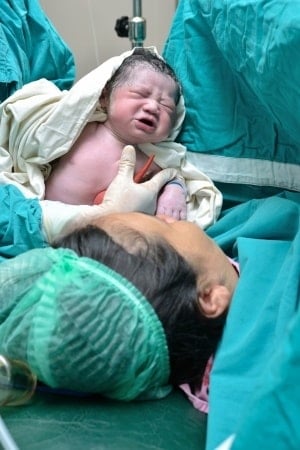A caesarian is another way to bring a baby into the world, and it’s very important to talk about it when preparing for childbirth. Pregnancy is like a box of chocolates—you never know what you’ll get.
A caesarian is a major surgery that helps avoid dangers for both the mother and baby. I know that many of you think that a cesarean will never be an option. You believe your pregnancy is going fine and you don’t anticipate needing one. However, sometimes reality will be something entirely different.
So, I think it’s important that future parents learn about cesareans just in case it’s necessary to have one. That is why I always talk about them in my prenatal web classes and in a video about cesarean childbirth. Parents that are prepared will be calmer, better understand the context, indications, and above all the risks of having or not having a cesarean. Many situations require it:
- An emergency
- Elective (planned)
- During labour
A gynecologist or surgeon will complete this procedure. If your family doctor is monitoring your pregnancy, they may assist the gynecologist during the surgery.
Parents that are prepared will be calmer, better understand the context, indications, and above all the risks of having or not having a cesarean.
An emergency caesarian usually takes place within minutes of an observed situation. For example, bleeding associated with placental detachment or a previa placenta (located in the cervix), a worrying lowering of the baby’s heartbeat or a cord prolapse (the cord descends into the pelvis in front of the baby’s head). In these circumstances, there is no time! Often, fathers or other significant people can’t even be present in the operating room given the execution speed and high-level attention and concentration required for the mother and baby. Additionally, if the mother giving birth isn’t already anesthetised, she may have to be put under to accelerate the procedure and quickly remove the baby.
Cord prolapse occurs in 0.1%-0.6% of deliveries and is more frequent:
- If the baby’s position in the uterus is transversal or oblique;
- If there is more amniotic fluid than usual;
- If the baby is premature or low-weight;
- If there is a premature rupture of the membranes.
The most common way to diagnose cord prolapse is to see it via the vaginal orifice or to palpate the interior of the vagina. The lowering of the baby’s heartbeat is a possible sign. If there is a true cord prolapse, pressure has to always be reduced on the umbilical cord to allow for oxygen exchange between the mother and baby while waiting for the caesarian, as this is an obstetrical emergency.
A planned cesarean refers to health situations that occur during the pregnancy, and reasons are known in advance to plan this surgery even before labour starts. Here are the most frequent examples:
- Poorly positioned placenta;
- A very large baby;
- Breech baby;
- Very small baby (which should avoid labour given its small size);
- Mother’s physical problems (fibroma, herpetic wound on the vulva) or chronic illness (poorly controlled diabetes);
- Mother already had a cesarean, and the cause is recurrent from her other deliveries (cervical incompetence or pelvis that is too small).
When a caesarian is scheduled, you might meet before the procedure to learn about the general aspects of the surgery (stages, the procedure and postnatal care). They will also take blood tests and send you the details for your home preparation before arriving in the maternity ward the day your caesarian is scheduled.
A cesarean can also not be scheduled or due to an emergency, but necessary nonetheless in some instances. For example, this procedure might be used during stalled labour (the cervix doesn’t change), the poor positioning of the baby preventing the descent into the pelvis, inefficient contractions, or a fetal heart that slows significantly during contractions.
The surgery requires the partial shaving of the pubis, installing an intravenous and catheter, anesthesia, surveillance of your vital signs (pressure, pulse, breathing). The cut will be made horizontally just above the pubis (bottom of the stomach) to access the uterus. The woman’s bladder will be emptied before the procedure using a catheter. It will be left there throughout the operation to avoid trauma during the procedure. For the most part, a woman who has a cesarean will remain awake during the surgery due to the regional anesthesia via epidural or spinal anesthesia. In rare cases, the mother will be put under to remove the baby, but it may be required in certain specific situations.
The surgery lasts for about 45 minutes when everything is ready, and the post-op monitoring period is about 1.5 hours. Convalescence is about six weeks after a cesarean. As such, it’s important to plan for help in the home for the 2–3 first weeks so that the mother can focus on her recovery and caring for the baby while gradually returning to her normal routine.
Now you know that when the doctor suggests a caesarian, they have already analysed the pros and cons to ensure that the benefits of the surgery are higher than the costs.
For more information about the benefits and costs of a caesarian, read the following articles:
- Experiencing a caesarian
- Forceps or cesarean
- The realities of childbirth
- Why take prenatal classes?
- Let’s talk placenta
- Epidural or spinal anesthesia
Also, watch these videos:
- Cesarean delivery, filmed in the operating room with Guy Waddell, gynecologist
- Analgesics and anesthetics, with Dr. Pirlet
Talk soon,
Marie
The Baby Expert
Feel free to share your experiences in the comment section.




